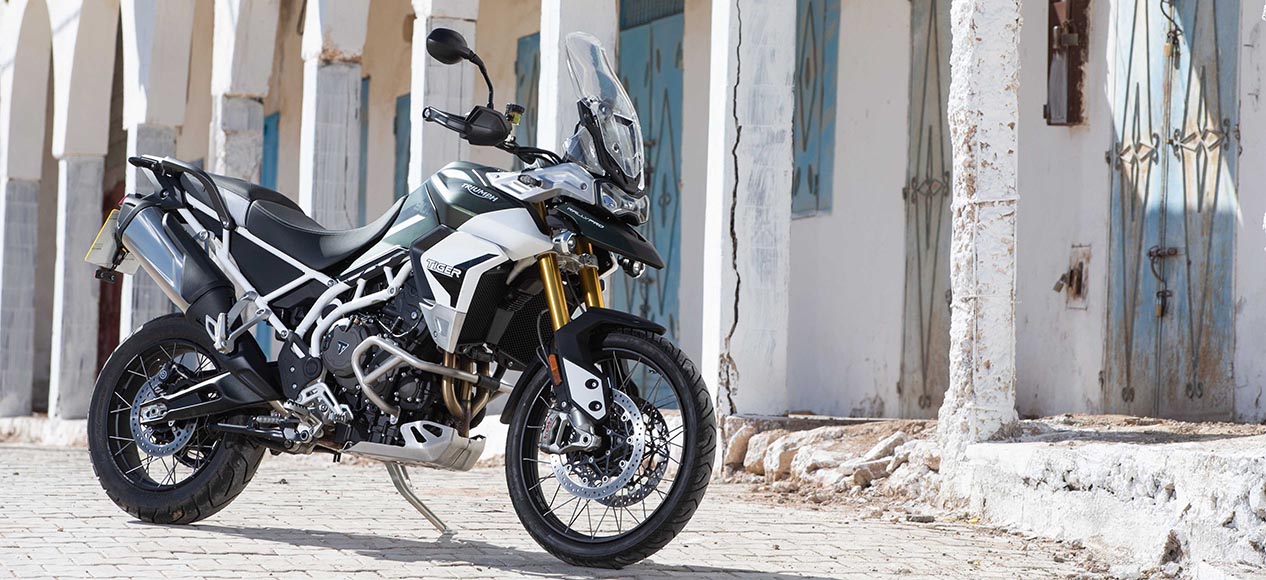Triumph’s popular Tiger 800 is no more! Replacing it for 2020 is the Tiger 900, an almost ground up new adventure bike with a bigger engine, higher spec and two main variants. While the base and GT models are aimed at pure road riders, the higher spec Rally models feature pumped up suspension for adventurers looking for a greater degree of off-road capability. Insidebikes sent leading freelance motorcycle journalist to the bike’s world press launch in Morocco to try out the range topping Rally Pro…
The Rally Pro is the more upmarket of the two off-road biased Rally variants, which both feature 21” wire-spoked front wheels (compared to the 19” cast alloy items on the base and GT models) and Showa suspension with extra travel – 240mm front and 230mm rear, with correspondingly taller seat heights of 850/870mm – an increase of 40mm on the other models.
Both Rally models match the GT roadsters by including a 7” TFT instrument panel, hand-guards, heated grips, cruise control, and under-seat USB charger, plus IMU-controlled cornering ABS. The basic Tiger 900 has a smaller screen and none of the other stuff. Like the GT Pro, the Rally Pro adds to that with a quick-shifter, LED fog lights, centre-stand, tyre pressure warning, heated seat and connectivity system.
It makes for a superbly well-equipped adventure bike that is genuinely capable off-road. The triple engine’s sweet throttle response and broad torque spread are as welcome here as with the GT, and the 900 unit’s irregular power pulses helped its chunky rear Pirelli (pure off-road Scorpion Rallies were fitted on our test bike instead of the standard Bridgestone Battlax Adventures) find controllable grip on the varied surface of sand and stones.
Bigger bang
All new Tiger models are powered by a new 888cc engine, an increase of 89cc on the old Tiger 800 unit. It adds roughly 10% more torque through most of the range, while keeping the maximum power output of 94bhp almost unchanged. All this improved performance despite being cleaner and fully Euro5 compliant.
It feels significantly different too, thanks to a revised firing order – designed to give one short gap between sparks, then two longer ones. Riders familiar with the old Tiger 800 will notice the change immediately. The Tiger fires up with a notably throatier sound and accelerates from low revs with a subtly different feel, almost more like a twin than the smooth-revving Tiger 800 with its ‘big bang’ 120-degree crankshaft.
The bigger-bore engine’s extra midrange delivery is welcome and the Rally Pro has six easily-changed riding modes, adding ‘Off-Road Pro’ to the GT Pro’s five settings: Road, Rain, Sport, Off-Road and a rider customisable mode. It’s a delightfully flexible powerplant, delivering usable shove from below 3000rpm, and making the Tiger effortlessly able to cruise at 80mph or more, and to accelerate from there towards a top speed of about 125mph.
Its new firing order helps the Tiger find traction on loose surfaces, and the extra suspension travel was welcome too, especially when clouting larger rocks on the occasional wider, faster sections of gravel track. The Rally Pro doesn’t have electronic shock adjustment but adds to its dirt-devouring ability with an aluminium bash-plate and the additional Off-road Pro riding mode – worthwhile even if it simply allows the traction control and ABS to be disabled.
A quick way of fine-tuning the traction control would be better, but in most respects the Tiger 900 Rally Pro is an excellent go-anywhere bike – powerful and comfortable enough for serious road trips, and sufficiently agile, robust and versatile to be hugely enjoyable off-road. At £13,100 it’s slightly more expensive than the GT Pro but is the Tiger to choose for taller riders and anyone planning to leave the black top behind.
What are the alternatives?
The Triumph Tiger 900 Rally Pro goes up against some heavyweight competition, including the F850GS Adventure, Honda’s similarly priced CRF1100L Africa Twin and KTM’s 790 Adventure R.
| Triumph Tiger 900 Rally Pro | |
|---|---|
| Engine type | Liquid-cooled transverse triple |
| Valve arrangement | DOHC, 12 valves |
| Displacement | 888cc |
| Bore x stroke | 78 x 61.9mm |
| Compression ratio | 11.27:1 |
| Fuelling | Multipoint sequential fuel-injection |
| Maximum power | 94bhp (70kW) @ 8250rpm |
| Maximum torque | 87N.m @ 7250rpm |
| Clutch | Wet multiplate |
| Transmission | 6-speed with two-way quick-shifter |
| Front suspension | 45mm telescopic upside-down Showa, 240mm travel, adjustable for preload, compression and rebound damping |
| Rear suspension | Showa monoshock, 230mm travel, adjustable for preload and rebound damping |
| Front brake | Twin four-piston Brembo Stylema radial monobloc calipers, 320mm discs with cornering ABS |
| Rear brake | Single-piston Brembo caliper, 255mm disc with cornering ABS |
| Front wheel | 2.15 x 21in; wire spoked |
| Rear wheel | 4.25 x 17in; wire spoked |
| Front tyre | 90/90 x 21in Bridgestone Battlax Adventure |
| Rear tyre | 150/70 x 17in Bridgestone Battlax Adventure |
| Rake/trail | 24.4 degrees/145.8mm |
| Wheelbase | 1551mm |
| Seat height | 850/870mm |
| Fuel capacity | 20 litres |
| Dry weight | 201kg |



